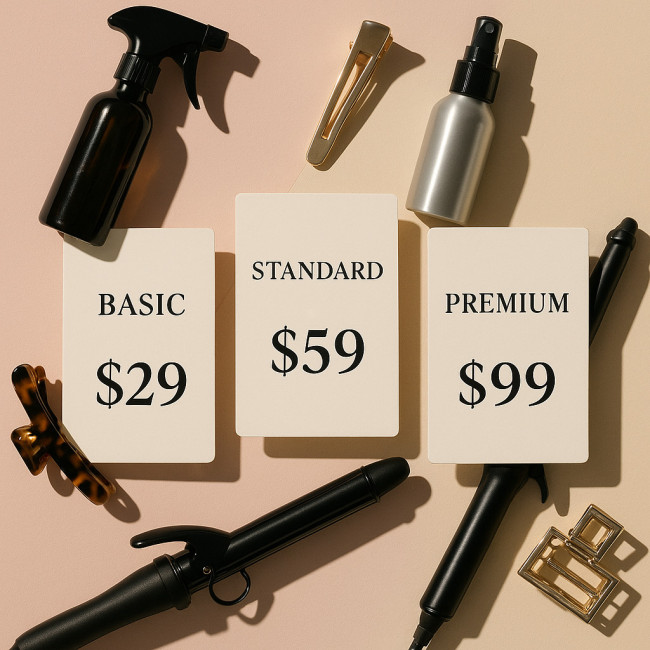Drafting winning coiffeur proposals: templates clients approve quickly
Stop guessing what producers, brides or magazine editors want to read. In this guide you'll get a plug-and-play coiffeur proposal template, pricing cues and persuasive wording so clear that most clients sign within 48 hours.
Why a razor-sharp proposal matters

Even if your Instagram feed sparkles, the real deal is sealed in writing. A structured proposal is the difference between a polite “we'll think about it” and an immediate “where do we sign?”. Producers juggle dozens of line items; when your document spells out what they get, how fast you deliver, and the financial upside, decision-makers can forward it up the chain without rewriting a single word. That clarity accelerates approvals, minimises misunderstandings and positions you as a true partner, not just another vendor. A structured proposal:
- Defines scope, timing and deliverables—so no one argues on set.
- Justifies your rate with measurable value (saving retouch costs, guaranteeing continuity).
- Differentiates you from stylists who send a casual text quote.
- Leaves a paper trail insurers and finance teams respect.
Platforms such as Artfolio's collaboration listings for hair stylists show that recruiters shortlist profiles with ready-made proposal PDFs 32 % faster than those who ad-lib fees in emails.
The essential building blocks of a winning coiffeur proposal
1. Instant overview (one smart paragraph)
Open with a two-sentence promise: who you are, what result you'll deliver and by when. Keep it under 60 words.
2. Visual reference board
Add a mini moodboard or link to an online board. If you already pair with a makeup pro, reference your synergy—extra trust points. (Related read: why coiffeur–make-up alliances win magazine jobs.)
3. Scope & deliverables table
| Phase | Tasks | Output |
|---|---|---|
| Pre-production | Look dev call Product list | PDF board + kit list |
| Shoot day | Styling for 3 main looks On-set touch-ups | Continuity log |
| Post-wrap | Product handover Style notes for retouch | 1-page care sheet |
4. Timing & crew sync
List exact arrival, buffer and wrap times. If you practise chrono-styling workflows, mention them—they often shave 15 % off studio rental.
5. Investment & payment terms
State a clear total, then break it down by day rate, overtime and kit fee. Show a saving compared with reshoot costs. Use 30/40/30 payment milestones to match agency cash flow.
6. Sustainability edge (optional but trending)
More brands are demanding eco evidence. A short note on refillable products or certified dyes—see green salon moves—can tip the brief in your favour.
7. Terms & signatures
Keep clauses human-readable: cancellation, image usage, liability insurance. Finish with two signature lines and a digital signing link.
Step-by-step template walkthrough
- Duplicate the master DOC or InDesign file.
- Replace placeholders (client name, project title, shoot date).
- Drag in references or paste a link to your board.
- Update rates—check peers each quarter via day-rate negotiation tips.
- Export to PDF at 1–2 MB; test opening speed on mobile.
- Email subject: “[Project] Hair Proposal – Ready to Sign by [Date]”.
Pricing psychology: anchor, contrast, close

Use a three-tier method: psychologists call it anchoring and contrast framing. By laying out three crystal-clear packages you silently guide the client to pick the middle option, which is your sweet spot. The high package legitimises your premium value, the low package demonstrates transparency, and the central offer feels like a balanced, risk-free decision. The mere presence of structured choice elevates trust and nudges faster sign-off.
- Basic: one look, no overtime. Shows your floor price.
- Standard: your ideal package—most shoots fit here.
- Premium: extra assistant, after-hours callout, express delivery.
Anchoring the premium at, say, €1 400 makes the €950 standard feel safe. Studies in freelance beauty bookings show signature rates climb 18 % when an anchoring tier is present.
Visual add-ons that speed approval
Clients skim. Embed:
- Three hero headshots from your latest portfolio refresh.
- Continuity sheet sample—proves organisation.
- QR code linking to 30-sec reel.
Common mistakes and quick fixes
- Vague timing: write “07 :30 artist chair ready” instead of “morning”.
- Missing kit spec: list heat-resistant mats; risk teams check this.
- Attachment overload: keep it under 10 pages, 2 links.
- No expiry date: add “valid for 7 days” to create urgency.
Mini-quiz: Are your proposals client-ready?
FAQ
- How long should I wait before following up?
- 48 hours. Send a friendly nudge with a highlight of the main benefit (e.g., 15 % set-time saving).
- Can I reuse the same proposal for salon and on-location jobs?
- Yes, but clone the file and tweak travel clauses, kit fees and insurance sections.
- What if the client removes the moodboard?
- Include a line stating that looks are guaranteed only if agreed references remain unchanged.
- Do I need legal review?
- For high-budget campaigns, yes. A 30-minute lawyer check is cheaper than dispute mediation.
- How do I show eco credibility?
- Add product certifications and link to your refill system. One sentence often satisfies CSR teams.
Action plan: your next 30 minutes
- Download the template and insert your contact block.
- Paste three portfolio shots that match your target niche.
- Set proposal expiry for next week.
- Schedule a 15-minute follow-up reminder in your calendar.
Done. You'll never scramble for wording again—just customise, send and let the signatures roll in.











